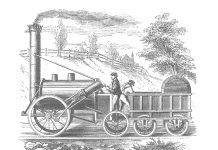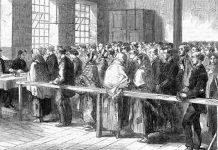The Whitworth, reopens its doors on 14 February 2015 following a £15million redevelopment project by MUMA (McInnes Usher McKnight Architects), that has transformed the 125 year-old building into a 21st-century gallery in the park.
The redevelopment, which has been supported by a major Heritage Lottery Fund grant, The University of Manchester and other funders, has doubled public space and created state-of-the-art new facilities including expanded gallery spaces, a study centre, learning studio, and a collections centre.
Leading with a major solo exhibition from one of Britain’s most acclaimed contemporary artists, Cornelia Parker, the opening programme celebrates the Whitworth’s eclectic and extensive collection of historical and contemporary fine art, textiles and wallpapers.
At the heart of MUMA’s major redevelopment project is the creation of an elegant glass, stainless steel and brick extension, which sees two wings extend into Whitworth Park from the back of the existing 19th-century building. For the extension, MUMA have developed a unique Whitworth blend of British brick and a brickwork pattern with a traditional textile slash work effect, inspired by the gallery’s extensive textile collection.
Drawing on the Whitworth’s heritage as the first English gallery in a park, the new wings create an art garden between them and are connected by a glass promenade gallery overlooking the surrounding landscape.
The landscape gallery wing provides exhibition space for the display of landscape works and large scale sculptures. Across the promenade, a beautiful linear café extends into the trees in Whitworth Park.
A large window in the centre of the existing building reveals a sight line into the main exhibition space, connecting the gallery to the surrounding park beyond.
This increased exhibition and public space allows the Whitworth to show, share and care for its significant collection of over 55,000 historical and contemporary works.
A new environmentally sustainable collection storage area has been created in the lower ground floor, including a public collections access area. Extensive refurbishment of the existing gallery building has restored the volume of the three 19th-century barrel-vault exhibition gallery ceilings enabling the display of major, large scale shows.
Visitors can now also gain access to the reinstated Grand Hall on the first floor through glorious Edwardian staircases returned to public use for the first time in over 50 years.
A £1.8m grant from the Arts Council England has completed the refurbishment with an improved entrance to the gallery on Oxford Road and Sculpture Terrace with works by Bernard Schottlander (Terminal, c.1965) and Gustav Metzger (Flailing Trees, 2009).
A new Art Garden and an Orchard Garden have been designed by Chelsea gold medalist Sarah Price, who co-designed the 2012 Olympic Park gardens in London and will be completed in spring 2015.
Grasses and perennial plants in the Art Garden will keep sight lines open whilst creating a sense of depth. Loosely clipped, evergreen hedging will be arranged to form rolling, distorted clouds varying in height and shape.
The hedging will be designed to look interesting from every angle and suggest partially enclosed interior spaces, creating backdrops suitable for displaying outdoor artworks.
Extending the exhibition space beyond the gallery walls, a significant number of new outdoor sculptures by artists including Christine Borland, Nate Lowman, Simon Periton and Nico Vascellari from a recent donation of 90 works from The Karpidas Foundation will go on permanent display in the Art Garden. The enclosed Orchard Garden and wildflower area will offer a place for relaxation and reflection as well as support the Whitworth’s work to promote the biodiversity of the park.
Dr Maria Balshaw, Director of the Whitworth, said: “We have long held the view that the gallery and the park should be a unified experience for our visitors. Our new building makes this a reality. The opening programme, led by Cornelia Parker’s remarkable exhibition, captures the spirit of the Whitworth – a place where marvellous, eclectic art works connect to people and our place in Manchester.”
The Whitworth programme opens with a major solo exhibition from one of Britain’s most acclaimed contemporary artists, Cornelia Parker whose work transforms ordinary objects into the compelling and the extraordinary. Featuring career-defining works such as Cold Dark Matter: An Exploded View (1991) and The Distance (A Kiss With String Attached) (2003), this exhibition also shows many new works that continue her preoccupation with dematerialising matter; bullets, blood and bronze are transformed into linear explorations. Unique to the Whitworth is War Room, a vast and immersive installation made from punched out paper negatives taken from the Poppy Factory in Richmond, its moiré of empty spaces echoing the 45 million remembrance poppies made each year.
The opening night of the exhibition will be marked by Cornelia Parker’s new ‘meteor shower’ work, Blakean Abstract. This has come about through a collaboration with the University of Manchester scientist, Kostya Novoselov, who, with Andre Geim, was awarded the Nobel Prize for his work on graphene – the thinnest and strongest known material. Working with a paper conservator, Novoselov took microscopic samples of graphite from drawings in the Whitworth’s collection by William Blake, Turner, Constable and Picasso as well as a pencil-written letter by Sir Ernest Rutherford (who split the atom in Manchester). He then made graphene from these samples. Parker will use the Blake graphene for this work of art to trigger a firework ‘meteor shower’ in Whitworth Park inspired by William Blake’s watercolour The Ancient of Days, which itself is part of the Whitworth’s collection.







